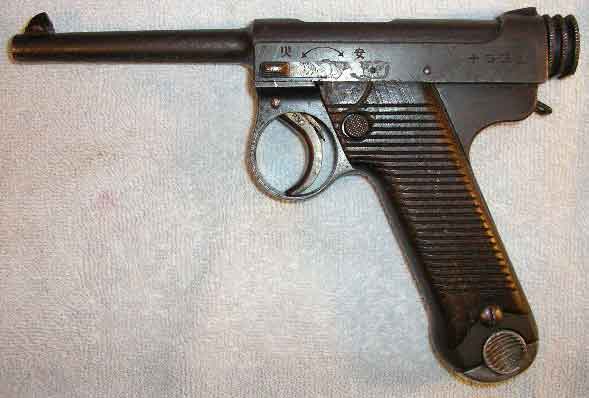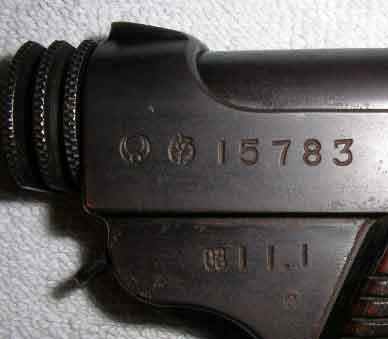Showa 11.1 Type 14 Photos
I got this 11.1 dated Kokubunji
factory pistol in August, 2004. A friend saw it for sale at a gun show in

The right side looks better than the
left. As you can see here, the left side has streaks of fairly deep corrosion,
whereas the right side just has a smattering of very light pitting in a few
spots. I have never done any experiments to confirm this, but collectors I know
refer to this as “blood corrosion”, allegedly occurring quite quickly in
limited areas from exposure to blood, e.g. if the original user fell with the
pistol across his chest. Although the exterior is a bit rough, the barrel is
excellent: shiny and with no pitting, just a little light wear. Note from the
corrosion pattern that the pitting seems to have happened while the safety lever
was in the safe position. Was the previous owner a casualty of the awkwardness
of operating the safety, which requires two hands? The person I bought it from
found this one a good shooter.

The markings in the top row identify
the pistol as a product of designer Kijiro Nambu’s own firm, the Nambu Rifle
Mfg. Co., which later merged and became known as Chuo Kogyo. The first symbol
in the upper left is the symbol of Nagoya Arsenal, which supervised production.
The second symbol just to the left of the serial number is a stylized version
of the character Nan or

An intriguing aspect of
this pistol is that it has British proof marks. On the left side of the frame
and barrel, just in front of the “fire” marking for the safety lever, are proof
marks: a crown above the letters “BNP”, which I think stands for “British Nitro
Proof”. One book I consulted said this mark was used by

There are more details
about the proof process on the underside of the barrel. The marks are hard to
read because they were applied over some fairly serious pitting, but they say:
8 M/M .812”
5 GRs N.C. [crossed swords symbol with a B to
the right]
102 “ BULLET
I think the .812” is a typo and
should be .312”. This would be somewhat undersize for an 8mm Nambu bullet,
though. I checked and it would also be too short for the case length. The
second line means “five grains nitrocellulose powder” and the third, “102 grain
bullet. It doesn’t specify what type of powder, but five grains is a lot of any
kind of pistol powder I am aware of. DON’T USE THAT LOAD. Most loading
data I have seen recommend around 3.5 grains depending on the powder used, but
you should always check reliable data for the specific powder you are using and
work up from a minimum load to an optimal load gradually. Proving involves
using a heavier than normal load to make sure the gun has a reserve of
strength. Using proof-level loads could cause serious problems that could be
fatal for both gun and user. If you are dumb enough to do that, well, there
will always be more fools being born to replace you, but they aren’t making any more Nambus, so blow up some other
less historic kind of gun!

Click here to go back to the Type 14 Photo
Gallery: t14gallery.htm
Click here to go back to the main page: jhg.htm
Last updated: September 1, 2004. All contents
are copyright Teri unless otherwise specified and may not be used elsewhere in
any form without prior permission.